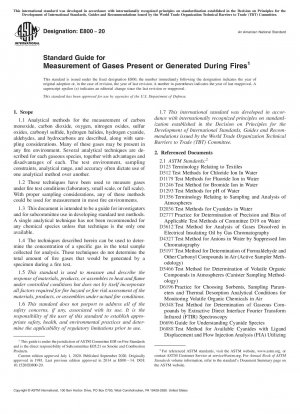ASTM E800-20
Standard Guide for Measurement of Gases Present or Generated During Fires
- Standard No.
- ASTM E800-20
- Release Date
- 2020
- Published By
- American Society for Testing and Materials (ASTM)
- Latest
- ASTM E800-20
- Scope
- 1.1 Analytical methods for the measurement of carbon monoxide, carbon dioxide, oxygen, nitrogen oxides, sulfur oxides, carbonyl sulfide, hydrogen halides, hydrogen cyanide, aldehydes, and hydrocarbons are described, along with sampling considerations. Many of these gases may be present in any fire environment. Several analytical techniques are described for each gaseous species, together with advantages and disadvantages of each. The test environment, sampling constraints, analytical range, and accuracy often dictate use of one analytical method over another. 1.2 These techniques have been used to measure gases under fire test conditions (laboratory, small scale, or full scale). With proper sampling considerations, any of these methods could be used for measurement in most fire environments. 1.3 This document is intended to be a guide for investigators and for subcommittee use in developing standard test methods. A single analytical technique has not been recommended for any chemical species unless that technique is the only one available. 1.4 The techniques described herein can be used to determine the concentration of a specific gas in the total sample collected for analysis. These techniques do not determine the total amount of fire gases that would be generated by a specimen during a fire test. 1.5 This standard is used to measure and describe the response of materials, products, or assembles to heat and flame under controlled conditions but does not by itself incorporate all factors required for fire hazard or fire risk assessment of the materials, products, or assemblies under actual fire conditions. 1.6 This standard does not purport to address all of the safety concerns, if any, associated with its use. It is the responsibility of the user of this standard to establish appropriate safety, health, and environmental practices and determine the applicability of regulatory limitations prior to use. 1.7 This international standard was developed in accordance with internationally recognized principles on standardization established in the Decision on Principles for the Development of International Standards, Guides and Recommendations issued by the World Trade Organization Technical Barriers to Trade (TBT) Committee.
ASTM E800-20 Referenced Document
- ASTM D1179 Standard Test Methods for Fluoride Ion in Water
- ASTM D123 Standard Terminology Relating to Textiles*, 2023-09-14 Update
- ASTM D1246 Standard Test Method for Bromide Ion in Water
- ASTM D1293 Standard Test Methods for pH of Water
- ASTM D1356 Standard Terminology Relating to Sampling and Analysis of Atmospheres*, 2024-04-21 Update
- ASTM D2036 Standard Test Methods for Cyanides in Water
- ASTM D2777 Standard Practice for Determination of Precision and Bias of Applicable Methods of Committee D-19 on Water
- ASTM D3612 Standard Test Method for Analysis of Gases Dissolved in Electrical Insulating Oil by Gas Chromatography
- ASTM D4327 Standard Test Method for Anions in Water by Chemically Suppressed Ion Chromatography
- ASTM D512 Standard Test Methods for Chloride Ion In Water
- ASTM D5197 Standard Test Method for Determination of Formaldehyde and Other Carbonyl Compounds in Air (Active Sampler Methodology)
- ASTM D5466 Standard Test Method for Determination of Volatile Organic Chemicals in Atmospheres (Canister Sampling Methodology)
- ASTM D6196 Standard Practice for Selection of Sorbents and Pumped Sampling/Thermal Desorption Analysis Procedures for Volatile Organic Compunds in Air
- ASTM D6348 Standard Test Method for Determination of Gaseous Compounds by Extractive Direct Interface Fourier Transform Infrared (FTIR) Spectroscopy
- ASTM D6696 Standard Guide for Understanding Cyanide Species*, 2023-11-15 Update
- ASTM D6888 Standard Test Method for Available Cyanides with Ligand Displacement and Flow Injection Analysis (FIA) Utilizing Gas Diffusion Separation and Amperometric Detection*, 2023-11-15 Update
- ASTM D7295 Standard Practice for Sampling Combustion Effluents and Other Stationary Sources for the Subsequent Determination of Hydrogen Cyanide
- ASTM D7309 Standard Test Method for Determining Flammability Characteristics of Plastics and Other Solid Materials Using Microscale Combustion Calorimetry*, 2021-10-01 Update
- ASTM D7365 Standard Practice for Sampling, Preservation and Mitigating Interferences in Water Samples for Analysis of Cyanide*, 2022-05-01 Update
- ASTM E1354 Standard Test Method for Heat and Visible Smoke Release Rates for Materials and Products Using an Oxygen Consumption Calorimeter
- ASTM E176 Standard Terminology of Fire Standards
- ASTM E2257 Standard Test Method for Room Fire Test of Wall and Ceiling Materials and Assemblies*, 2022-04-01 Update
- ASTM E337 Standard Test Method for Measuring Humidity with a Psychrometer (the Measurement of Wet- and Dry-Bulb Temperatures)
- ASTM E535 Standard Practice for Preparation of Fire-Test-Response Standards*, 2023-11-01 Update
- ASTM E603 Standard Guide for Room Fire Experiments
- ASTM E662 Standard Test Method for Specific Optical Density of Smoke Generated by Solid Materials
- ASTM E84 Standard Test Method for Surface Burning Characteristics of Building Materials
ASTM E800-20 history
- 2020 ASTM E800-20 Standard Guide for Measurement of Gases Present or Generated During Fires
- 2014 ASTM E800-14 Standard Guide for Measurement of Gases Present or Generated During Fires
- 2007 ASTM E800-07 Standard Guide for Measurement of Gases Present or Generated During Fires
- 2006 ASTM E800-06 Standard Guide for Measurement of Gases Present or Generated During Fires
- 2005 ASTM E800-05 Standard Guide for Measurement of Gases Present or Generated During Fires
- 2001 ASTM E800-01 Standard Guide for Measurement of Gases Present or Generated During Fires
- 1999 ASTM E800-99 Standard Guide for Measurement of Gases Present or Generated During Fires
